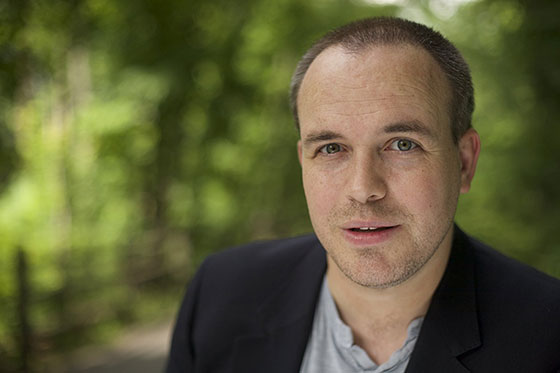Interview: Director Peter Stray talks ‘Canaries’

How did you first get into filmmaking?
Growing up in Swansea, there was a strong arts lineage thanks to local youth theatres and the legacy of Dylan Thomas. I was always into acting and was a child of the movies. I learnt a lot from BBC2 documentaries interviewing directors, from Ken Loach to Brian DePalma. Also, my mum is a Professor of Anthropology and her department at Swansea University was in the same building as media resources, so I was able to borrow SVHS cameras and learn to edit on the giant VHS editing decks they had back in the day! I learnt by doing.
What can we expect from your first feature film Canaries?
You can expect some laughs, scares, sci-fi intrigue and some political / social subtext should you go looking for it. Mostly it’s just a fun tale to be enjoyed with a beer and friends.
Can you explain the meaning behind the title Canaries?
It came to me when I had a dream about many figures in yellow rain macs dotted about a stark Welsh landscape – the title and that image. So, I had to then justify it. It’s not quite as cryptic as Resevoir Dogs (1992) say, in that the DOD in the film is calling the investigation “Project Canary”. As a UFO nerd, I knew that the last official investigation into aliens was called Project Blue Book, so the progression of B to C and Blue to canary-yellow implied it was the next phase of the investigation. Some people have also commented it’s a Welsh reference as Canaries were used to sense the first sign of danger in coal mines.
What was the inspiration for writing Canaries and why did you decide to do a horror comedy?
Apart from the dream mentioned above, it was about the bucket list – If a piano dropped on my head in two years, what would I wanted to have done with my life? The answer was obvious – write an alien-horror-comedy with action and laughs set in Lower Cwmtwrch! Tonally The Lost Boys (1987) was a huge inspiration – I remember seeing that as a teenager and loving the sensation of jump-scares mixed with laughs. That not every genre has to be confined to its own box.
Why did you decide to stage the invasion in a small welsh town?
Wales has provided amazing locations in film for decades – it was the Yorkshire moors in American Werewolf in London (1981), it was part of the bat cave even – but it hasn’t played itself often. I wanted to give Wales a chance to ‘play itself’. And story-wise, we know what happens when aliens threaten Washington, New York, and even small-town America – but watching every movie involving a global invasion, I’m sure may people have wondered, ‘what was going on in my neck of the woods during all this? We know how Will Smith handles aliens, what about my mates from the pub?’
The film challenges conventional perceptions of the characters in how they react when their lives are in danger. Was this important for you to portray in the film?
Absolutely. I think in some films, characters with special skills just snap into ‘awesome mode’ and show no fear, but even if you’re trained in martial arts, you might still be terrified! That’s what I wanted to get across. Even though the situation is fantastical and ridiculous I think it’s important to ground characters and their reactions in reality. Also as an audience member I’m willing to take a leap of imagination about flying saucers, but not about human beings behaving in a way I’ve never seen them behave in real life.
Canaries was made internationally with both locations during filming and post production. How did this come together considering the films modest budget?
Robert Rodriguez talked about using what you have when writing films in interviews about El Mariachi (1993). I’m lucky in that I had access to amazing Welsh actors, a friend who lived in Vietnam and in-laws who live on Martha’s Vineyard! Craig Russell (producer and actor-Steve Dennis) – connected us with so much talent on the UK end, which was the bulk of production and post-production. Luckily people really liked the project, so through Craig we had Milk VFX (Oscar winners for Ex Machina (2014)) giving us time and talent and Kevin McCurdy (Doctor Who, Hinterland, RSC etc) doing our fights and stunts.
What were your influences for the look and the style of the film?
I wanted aspects of it to look as if it were based on a graphic novel, but not something too cartoony – Alex Nevill (our great DP) and me had many discussions about that. We used pops of primary colour against muted, earthy tones to create a feel of the fantastical emerging from the mundane. Artificial Peach, a grading company in New York helped with this too – the look of the US scenes were inspired by the Bourne movies and Tony Scott films – the first half of the Welsh scenes almost have a naturalistic BBC drama feel, then it becomes a bit more John Carpenter as the weirdness increases. Alex got us these great 70s prime lenses, so we have a slightly old school feel.
Where there any elements of the finished film which were different to the original script?
There were a couple of things trimmed for simplicity, and one deleted scene – I’m a very collaborative writer/director so I was refining and changing lines on set with actors, and allowed them to improv if there was time. In many cases actors gave such great performances I didn’t need some of the dialogue I’d written – if they can sell the idea from lines 1-3, I realised on set or in the edit that the audience doesn’t need lines 4 – 6.
What was one of your favourite scenes in the film?
It’s not one scene, but I love the ‘fight tryptych’, which is the centrepiece of the film – three fights for the price of one! Also, the ‘one-er’ in the kitchen where characters plan how to escape. That was like directing a mini-play, but luckily with quality theatre actors it came off wonderfully.
How did the look of the aliens come about and what was the inspiration for the design?
I wanted to create a new villain that wasn’t a zombie or a vampire for my first film. Of course, it’s low budget but I thought fishermen injected with alien DNA would create a striking and simple image and give us something new. Some people have told me they get a slight panic reflex when they see someone in a yellow rain mac now!
The film is left open for a potential sequel. Do you know how you would look to expand on the current story?
I have written an outline for a sequel and would love to do it. I love these characters so much that I’d honestly continue the story drawing with crayons myself if I had to!
Do you have any new projects which you are working on?
Yes, I have a screenplay that’s been optioned by an American indie company, a pilot for BBC Wales and of course more features planned with Craig as my artistic partner. We’ve been mates for years and it was great to find we love working together. The next project would be another genre piece shot in Wales – BAFTA Cyrmu has been super supportive of Canaries and I think they recognise our passion. I’m biased because I was born there, but Wales is a beautiful country with tremendous actors, crew and locations – it’s already becoming the British Columbia of the UK and I’d love to shoot there again if they’ll have us back!
______
If you haven’t read it yet, check out our Canaries review.











































